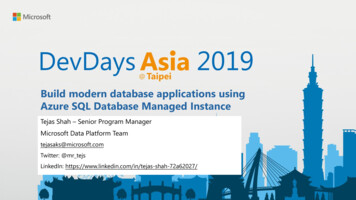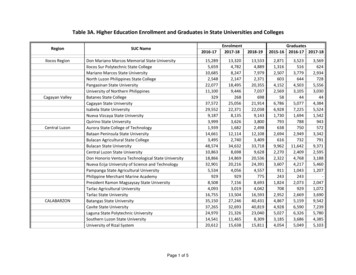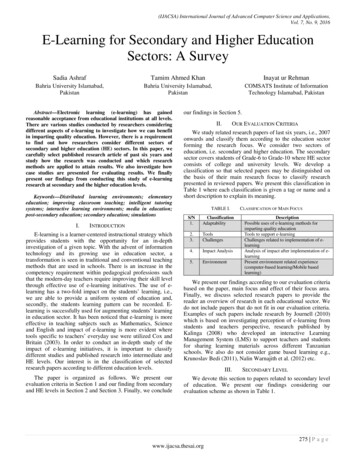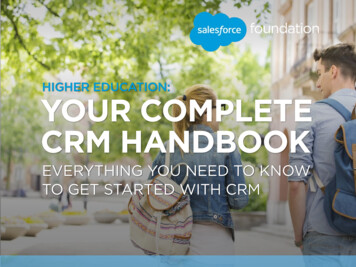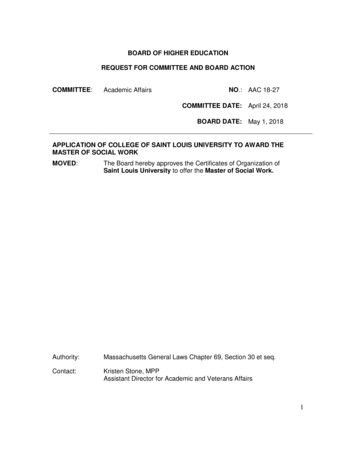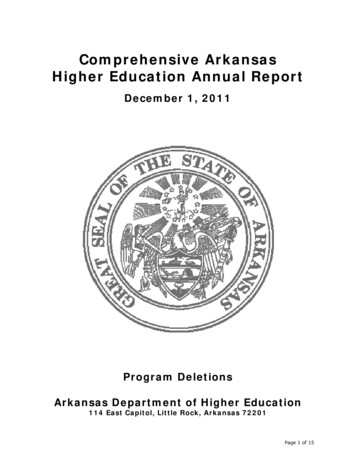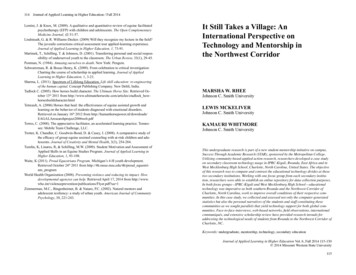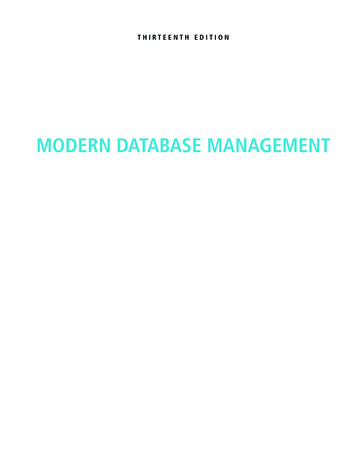
Transcription
THIRTEENTH EDITIONMODERN DATABASE MANAGEMENT
THIRTEENTH EDITIONMODERN DATABASE MANAGEMENTJeffrey A. HofferUniversity of DaytonV. RameshIndiana UniversityHeikki TopiBentley University
Vice President, IT & Careers: Andrew GilfillanSenior Portfolio Manager: Samantha LewisManaging Producer: Laura BurgessAssociate Content Producer: Stephany HarringtonPortfolio Management Assistant: Madeline HouptDirector of Product Marketing: Brad ParkinsProduct Marketing Manager: Heather TaylorProduct Marketing Assistant: Jesika BetheaField Marketing Manager: Molly SchmidtField Marketing Assistant: Kelli FisherCover Image: VICTOR HABBICK VISIONS/Getty ImagesVice President, Product Model Management: Jason FournierSenior Product Model Manager: Eric HakansonLead, Production and Digital Studio: Heather DarbyDigital Studio Course Producer: Jaimie NoyProgram Monitor: Danica Monzor, SPi GlobalFull-Service Project Management:Neha Bhargava, Cenveo Publisher ServicesComposition: Cenveo Publisher ServicesPrinter/Binder: LSC CommunicationsCover Printer: Phoenix ColorText Font: Palatino LT ProCredits and acknowledgments borrowed from other sources and reproduced, with permission, in this textbook appear on the appropriate pagewithin text.Microsoft and/or its respective suppliers make no representations about the suitability of the information contained in the documents andrelated graphics published as part of the services for any purpose. All such documents and related graphics are provided “as is” withoutwarranty of any kind. Microsoft and/or its respective suppliers hereby disclaim all warranties and conditions with regard to this information,including all warranties and conditions of merchantability, whether express, implied or statutory, fitness for a particular purpose, title and noninfringement. In no event shall Microsoft and/or its respective suppliers be liable for any special, indirect or consequential damages or anydamages whatsoever resulting from loss of use, data or profits, whether in an action of contract, negligence or other tortious action, arising outof or in connection with the use or performance of information available from the services.The documents and related graphics contained herein could include technical inaccuracies or typographical errors. Changes are periodicallyadded to the information herein. Microsoft and/or its respective suppliers may make improvements and/or changes in the product(s) and/orthe program(s) described herein at any time. Partial screen shots may be viewed in full within the software version specified.TrademarksMicrosoft Windows , and Microsoft Office are registered trademarks of the Microsoft Corporation in the U.S.A. and other countries. Thisbook is not sponsored or endorsed by or affiliated with the Microsoft Corporation.Copyright 2019, 2016, 2013 by Pearson Education, Inc. All rights reserved. Manufactured in the United States of America. This publicationis protected by Copyright, and permission should be obtained from the publisher prior to any prohibited reproduction, storage in a retrievalsystem, or transmission in any form or by any means, electronic, mechanical, photocopying, recording, or likewise. For information regardingpermissions, request forms and the appropriate contacts within the Pearson Education Global Rights & Permissions department, please s of third party content appear on the appropriate page within the text, which constitutes an extension of this copyright page.Unless otherwise indicated herein, any third-party trademarks that may appear in this work are the property of their respective owners andany references to third-party trademarks, logos or other trade dress are for demonstrative or descriptive purposes only. Such references arenot intended to imply any sponsorship, endorsement, authorization, or promotion of Pearson’s products by the owners of such marks, or anyrelationship between the owner and Pearson Education, Inc. or its affiliates, authors, licensees or distributors.Library of Congress Cataloging-in-Publication DataNames: Hoffer, Jeffrey A., author. Ramesh, V. (Venkataraman), author. Topi, Heikki, author.Title: Modern database management / Jeffrey A. Hoffer, University of Dayton,V. Ramesh, Indiana University, Heikki Topi, Bentley University.Description: Thirteenth edition. Boston : Pearson Education, [2017] Includes bibliographical references and index.Identifiers: LCCN 2017048422 ISBN 9780134773650 (alk. paper) ISBN 0133544613 (alk. paper)Subjects: LCSH: Database management.Classification: LCC QA76.9.D3 M395 2017 DDC 005.75–dc23 LC record available at https://lccn.loc.gov/201704842210 9 8 7 6 5 4 3 2 1ISBN 10: 0-13-477365-9ISBN 13: 978-0-13-477365-0
To Patty, for her sacrifices, encouragement, and support for more than 35 yearsof being a textbook author widow. To my students and colleagues, for beingreceptive and critical and for challenging me to be a better teacher.—J.A.H.To Gayathri, for her sacrifices and patience these past 25 years. To my parents, forletting me make the journey abroad, and to my cat, Raju, who was a part of ourfamily for more than 20 years.—V.R.To Anne-Louise, for her loving support, encouragement, and patience. To Leilaand Saara, whose laughter and joy of life continue to teach me about what istruly important. To my teachers, colleagues, and students, from whom I continueto learn every day.—H.T.
BRIEF CONTENTSPart IThe Context of Database ManagementChapter 11The Database Environment and Development Process3Part II Database Analysis and Logical Design 53Chapter 2Chapter 3Chapter 4Modeling Data in the Organization 55The Enhanced E-R Model 115Logical Database Design and the Relational Model153Part III Database Implementation and Use 205Chapter 5Chapter 6Chapter 7Chapter 8Introduction to SQL 207Advanced SQL 251Databases in Applications 297Physical Database Design and Database Infrastructure 333Part IV Advanced Database Topics385Data Warehousing and Data Integration 387Big Data Technologies 444Analytics and Its Implications 474Data and Database Administration with Focuson Data Quality 503Glossary of Acronyms 529Glossary of Terms 531Index 539Chapter 9Chapter 10Chapter 11Chapter 12Available Online at www.pearsonhighered.com/hofferChapter 13 Distributed Databases 13-1Chapter 14 Object-Oriented Data Modeling14-1AppendicesAppendix A Data Modeling Tools and NotationAppendix B Advanced Normal Forms B-1Appendix C Data Structures C-1A-1vii
CONTENTSPreface xxvPart IThe Context of Database Management1An Overview of Part I 1Chapter 1 The Database Environment and Development Process3Learning Objectives 3Data Matter! 4Introduction 5Basic Concepts and Definitions 6Data 6Data versus Information 7Metadata 8Traditional File Processing Systems 9File Processing Systems at Pine Valley Furniture Company 9Disadvantages of File Processing Systems 10Program-Data Dependence 10Duplication of Data 10Limited Data Sharing 10Lengthy Development Times 10Excessive Program Maintenance 11The Database Approach 11Data Models 11Entities 11Relationships 11Relational Databases 12Database Management Systems 13Advantages of the Database Approach 13Program-Data Independence 13Planned Data Redundancy 14Improved Data Consistency 14Improved Data Sharing 14Increased Productivity of Application Development 14Enforcement of Standards 15Improved Data Quality 15Improved Data Accessibility and Responsiveness 15Reduced Program Maintenance 16Improved Decision Support 16Cautions about Database Benefits 16Costs and Risks of the Database Approach 16New, Specialized Personnel 16Installation and Management Cost and Complexity 17Conversion Costs 17Need for Explicit Backup and Recovery 17Organizational Conflict 17Integrated Data Management Framework 17Components of the Database Environment 18ix
xContentsThe Database Development Process 20Systems Development Life Cycle 21Planning—Enterprise Modeling 21Planning—Conceptual Data Modeling 21Analysis—Conceptual Data Modeling 22Design—Logical Database Design 23Design—Physical Database Design and Definition 23Implementation—Database Implementation 23Maintenance—Database Maintenance 24Alternative Information Systems Development Approaches 24Three-Schema Architecture for Database Development 25Managing the People Involved in Database Development 27Evolution of Database Systems 271960s 291970s 291980s 291990s 302000 and Beyond 30The Range of Database Applications 30Personal Databases 31Departmental Multi-Tiered Client/Server Databases 31Enterprise Applications 32Enterprise Systems 32Data Warehouses 33Data Lake 34Developing a Database Application for Pine Valley FurnitureCompany 35Database Evolution at Pine Valley Furniture Company 36Project Planning 36Analyzing Database Requirements 37Designing the Database 40Using the Database 42Administering the Database 43Future of Databases at Pine Valley 43Summary 44 Key Terms 45 Review Questions 45 Problems and Exercises 46 Field Exercises 48 References 49 Further Reading 49 Web Resources 50CASE: Forondo Artist Management Excellence Inc. 51Part II Database Analysis and Logical Design 53An Overview of Part II 53Chapter 2 Modeling Data in the Organization55Learning Objectives 55Introduction 55The E-R Model: An Overview 58Sample E-R Diagram 58E-R Model Notation 60Modeling the Rules of the Organization 61
ContentsOverview of Business Rules 62The Business Rules Paradigm 62Scope of Business Rules 63Good Business Rules 63Gathering Business Rules 64Data Names and Definitions 64Data Names 64Data Definitions 65Good Data Definitions 65Modeling Entities and Attributes 67Entities 67Entity Type versus Entity Instance 67Entity Type versus System Input, Output, or User 67Strong versus Weak Entity Types 68Naming and Defining Entity Types 69Attributes 71Required versus Optional Attributes 71Simple versus Composite Attributes 72Single-valued versus Multivalued Attributes 72Stored versus Derived Attributes 73Identifier Attribute 73Naming and Defining Attributes 74Modeling Relationships 76Basic Concepts and Definitions in Relationships 77Attributes on Relationships 78Associative Entities 78Degree of a Relationship 80Unary Relationship 81Binary Relationship 82Ternary Relationship 82Attributes or Entity? 83Cardinality Constraints 85Minimum Cardinality 85Maximum Cardinality 86Some Examples of Relationships and Their Cardinalities 86A Ternary Relationship 87Modeling Time-Dependent Data 88Modeling Multiple Relationships Between Entity Types 90Naming and Defining Relationships 92E-R Modeling Example: Pine Valley Furniture Company 93Database Processing At Pine Valley Furniture 96Showing Product Information 96Showing Product Line Information 96Showing Customer Order Status 97Showing Product Sales 98Summary 99 Key Terms 100 Review Questions 100 Problems and Exercises 101 Field Exercises 111 References 112 Further Reading 112 Web Resources 112CASE: Forondo Artist Management Excellence Inc. 113xi
xiiContentsChapter 3 The Enhanced E-R Model115Learning Objectives 115Introduction 115Representing Supertypes and Subtypes 116Basic Concepts and Notation 117An Example of a Supertype/Subtype Relationship 118Attribute Inheritance 119When to Use Supertype/Subtype Relationships 119Representing Specialization and Generalization 120Generalization 120Specialization 121Combining Specialization and Generalization 122Specifying Constraints in Supertype/Subtype Relationships 123Specifying Completeness Constraints 123Total Specialization Rule 123Partial Specialization Rule 123Specifying Disjointness Constraints 124Disjoint Rule 124Overlap Rule 125Defining Subtype Discriminators 125Disjoint Subtypes 125Overlapping Subtypes 126Defining Supertype/Subtype Hierarchies 127An Example of a Supertype/Subtype Hierarchy 128Summary of Supertype/Subtype Hierarchies 128EER Modeling Example: Pine Valley Furniture Company 128Entity Clustering 132Packaged Data Models 135A Revised Data Modeling Process with Packaged Data Models 137Packaged Data Model Examples 139Summary 144 Key Terms 145 Review Questions 145 Problems and Exercises 146 Field Exercises 149 References 149 Further Reading 150 Web Resources 150CASE: Forondo Artist Management Excellence Inc. 151Chapter 4 Logical Database Design and the Relational ModelLearning Objectives 153Introduction 153The Relational Data Model 154Basic Definitions 154Relational Data Structure 155Relational Keys 155Properties of Relations 156Removing Multivalued Attributes from Tables 156Sample Database 157Integrity Constraints 158Domain Constraints 158Entity Integrity 158Referential Integrity 160153
ContentsCreating Relational Tables 161Well-Structured Relations 162Transforming EER Diagrams into Relations 163Step 1: Map Regular Entities 164Composite Attributes 164Multivalued Attributes 165Step 2: Map Weak Entities 165When to Create a Surrogate Key 166Step 3: Map Binary Relationships 167Map Binary One-to-Many Relationships 167Map Binary Many-to-Many Relationships 168Map Binary One-to-One Relationships 168Step 4: Map Associative Entities 169Identifier not Assigned 169Identifier Assigned 170Step 5: Map Unary Relationships 171Unary One-to-Many Relationships 171Unary Many-to-Many Relationships 172Step 6: Map Ternary (and n-ary) Relationships 173Step 7: Map Supertype/Subtype Relationships 174Summary of EER-to-Relational Transformations 176Introduction to Normalization 176Steps in Normalization 177Functional Dependencies and Keys 177Determinants 179Candidate Keys 179Normalization Example: Pine Valley Furniture Company 180Step 0: Represent the View in Tabular Form 180Step 1: Convert to First Normal Form 181Remove Repeating Groups 181Select the Primary Key 182Anomalies in 1NF 182Step 2: Convert to Second Normal Form 183Step 3: Convert to Third Normal Form 184Removing Transitive Dependencies 184Determinants and Normalization 185Step 4: Further Normalization 185Merging Relations 186An Example 186View Integration Problems 186Synonyms 187Homonym
MODERN DATABASE MANAGEMENT Jeffrey A. Hoffer University of Dayton V. Ramesh Indiana University Heikki Topi Bentley University THIRTEENTH EDITION. Credits and acknowledgments borrowed from other sources and reproduced, with permission, in this textbook appear on the appropriate page within text. Microsoft and/or its respective suppliers make no representations about the suitability
